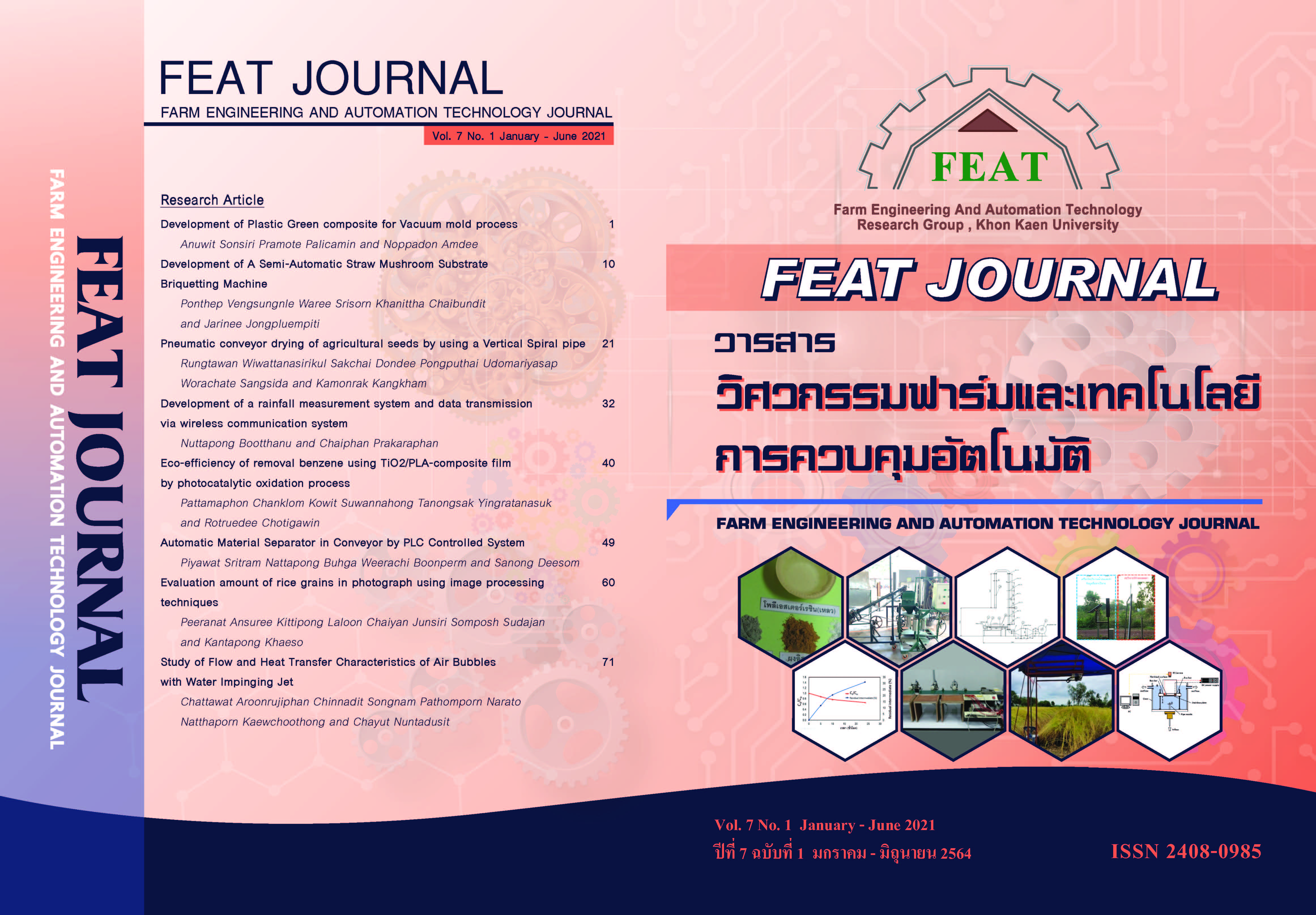ประสิทธิภาพเชิงนิเวศเศรษฐกิจในการบำบัดไอระเหยเบนซีนของ TiO2/PLA-composite film ด้วยกระบวนการโฟโตคะตะไลติกออกซิเดชัน
Main Article Content
บทคัดย่อ
การประเมินความคุ้มค่าทางเศรษฐกิจของเทคโนโลยีบำบัดอากาศด้วยกระบวนการโฟโตคะตะไลติกออกซิเดชันเป็นวิธีการนำไปสู่การประยุกต์ใช้ในการออกแบบเครื่องฟอกอากาศอย่างมีประสิทธิภาพ งานวิจัยนี้มีวัตถุประสงค์เพื่อศึกษาความคุ้มค่าเชิงนิเวศเศรษฐกิจในการบำบัดเบนซีนด้วยกระบวนการโฟโตไลสิสเทียบกับกระบวนการโฟโตคะตะไลติกออกซิเดชันโดยใช้ฟิล์ม 5%TiO2/PLA ที่ผ่านการสังเคราะห์ด้วยกระบวนการเป่าฟิล์ม ฟิล์มที่สังเคราะห์ได้วิเคราะห์ด้วย SEM พบว่าไททาเนียมไดออกไซด์กระจายตัวบนแผ่นฟิล์มเป็นอย่างดี วิเคราะห์ด้วย UV-VIS พบว่าค่าแถบพลังงานเท่ากับ 3.22 อิเล็กตรอนโวลต์ ซึ่งเป็นลักษณะของผลึกอนาเทส และตรวจด้วย ATR-FTIR พบโครงสร้างของไททาเนียมไดออกไซด์และพีแอลเอ จากผลการศึกษาพบว่าการบำบัดเบนซีนด้วยกระบวนการโฟโตคะตะไลติกออกซิเดชันและกระบวนการโฟโตไลสิสนาน 24 ชั่วโมง มีประสิทธิภาพเท่ากับ 44% และ 9% ตามลำดับ โดยเบนซีนถูกเปลี่ยนเป็นคาร์บอนไดออกไซด์และน้ำซึ่งเข้าได้กับปฏิกิริยาอันดับหนึ่งที่มีอัตราเร็วการเกิดปฏิกิริยาเท่ากับ 0.0188 และ 0.0133 ตามลำดับ ความคุ้มค่าเชิงนิเวศเศรษฐกิจเท่ากับ 0.346 และ 0.007 ตามลำดับ ดังนั้นกระบวนการโฟโตคะตะไลติกออกซิเดชันที่ใช้ 5%TiO2/PLA สามารถบำบัดเบนซีนได้อย่างมีประสิทธิภาพและมีความคุ้มค่าเชิงนิเวศเศรษฐกิจ
Article Details
วารสารวิศวกรรมฟาร์มและเทคโนโลยีควบคุมอัตโนมัติ (FEAT Journal) มีกําหนดออกเป็นราย 6 เดือน คือ มกราคม - มิถุนายน และ กรกฎาคม - ธันวาคม ของทุกปี จัดพิมพ์โดยกลุ่มวิจัยวิศวกรรมฟาร์มและเทคโนโลยีควบคุมอัตโนมัติ คณะวิศวกรรมศาสตร์มหาวิทยาลัยขอนแก่น เพื่อเป็นการส่งเสริมและเผยแพร่ความรู้ ผลงานทางวิชาการ งานวิจัยทางด้านวิศวกรรมศาสตร์และเทคโนโลยีพร้อมทั้งยังจัดส่ง เผยแพร่ตามสถาบันการศึกษาต่างๆ ในประเทศด้วย บทความที่ตีพิมพ์ลงในวารสาร FEAT ทุกบทความนั้นจะต้องผ่านความเห็นชอบจากผู้ทรงคุณวุฒิในสาขาที่เกี่ยวข้องและสงวนสิทธิ์ ตาม พ.ร.บ. ลิขสิทธิ์ พ.ศ. 2535
เอกสารอ้างอิง
Cincinelli A, Martellini T. Indoor Air Quality and Health. International journal of environmental research and public health 2017; 14(11): 1286.
Pei J, Dong C Liu J. Operating behavior and corresponding performance of portable air cleaners in residential buildings. China. Building and Environment. 2019; 147: 473-81.
Chung EK, Jang JK, Koh DH. A comparison of benzene exposures in maintenance and regular works at Korean petrochemical plants. Journal of Chemical Health and Safety. 2017; 24(3), 21-6.
Bouchaala. Volatile Organic Compound Removal Method: A Review. American Journal of Biochemistry and Biotechnology. 2012; 8: 220-9.
Torpy F, Clements N, Pollinger M, Dengel A, Mulvihill I, He C, et al. Testing the single-pass VOC removal efficiency of an active green wall using methyl ethyl ketone. Air quality, atmosphere and health. 2018; 11(2): 163-70.
Filho BMC, Silva GV, Boaventura RAR, Dias MM, Lopes JCB, Vilar VJP. Ozonation and ozone-enhanced photocatalysis for VOC removal from air streams: Process optimization, synergy and mechanism assessment. Science of The Total Environment. 2019; 687: 1357-68.
Shah WK, Li W. A Review on Catalytic Nanomaterials for Volatile Organic Compounds VOC Removal and Their Applications for Healthy Buildings. Nanomaterials 2019; 9(6): 910.
He C, Cheng J, Zhang X, Douthwaite M, Pattisson S, Haoet Z. Recent Advances in the Catalytic Oxidation of Volatile Organic Compounds: A Review Based on Pollutant Sorts and Sources. Chemical Reviews. 2019; 119(7): 4471-568.
Sendogdular ST, Gouma P. A Brief Overview of TiO2 Photocatalyst for Organic Dye Remediation: Case Study of Reaction Mechanisms Involved in Ce-TiO2 Photocatalysts System. Journal of Nanomaterials. 2018; 13.
Khami S, Khamwichit W, Rangkupan R, Suwannahong K. Volatile Organic Compound (VOC) Removal via Photocatalytic Oxidation Using TiO2 Coated Nanofilms. Walailak Journal of Science and Technology. 2017; 15(7): 491-501.
Huang Y, Ho SSH, Lu Y, Niu R, Xu L, Cao J, et al. Removal of Indoor Volatile Organic Compounds via Photocatalytic Oxidation: A Short Review and Prospect. Molecules. 2016; 21(1): 56.
Djellabi R, Ali J, Zhao X, Saber A. CuO NPs incorporated into electron-rich TCTA@PVP photoactive polymer for the photocatalytic oxidation of dyes and bacteria inactivation. Journal of Water Process Engineering. 2020; 36: 101238.
Regmi C, Joshi B, Rau SK, Gyawala G, Pandwt RP. Understanding Mechanism of Photocatalytic Microbial Decontamination of Environmental Wastewater. Frontiers in Chemistry. 2018; 6(33): 1-6.
Suwannahong K, Sirivithayaoakorn S, Noophan P, Sanongraj W. Improvement of TiO2/LDPE Composite Films for Photocatalytic Oxidation of Acetone. Advanced Materials Research. 2014; 931-932: 235-40.
Muangmora R, Kemacheevakul P, Chuangchote S. Removal of gaseous benzene by photocatalytic oxidation process using TiO2 film coated on glass sheets under UVC irradiation. Thai Environmental Engineering Journal. 2019; 33(3): 9-16.
Rachel A, Subrahmanyam M, Boule P. Comparison of photocatalytic efficiencies of TiO2 in suspended and immobilised form for the photocatalytic degradation of nitrobenzenesulfonic acids. Applied Catalysis B: Environmental. 2002; 37(4): 301-8.
Sriwong C, Wongnawa S, Patarapaiboolchaib O. Rubber sheet strewn with TiO2 particles: Photocatalytic activity and recyclability. Journal of Environmental Sciences. 2012; 24(3): 464-72.
Lackner M. Kirk‐Othmer Encyclopedia of Chemical Technology. John Wiley & Sons Inc: New Jersey; 2015.
Chanklom P, Yingratanasuk T, Chotigawin R, Suwannahong K. Improvement of PLA/TiO2-composite film for photocatalytic VOCs degradation. Conference of Sustainable Development of Energy, Water and Environment Systems; 2020 April 6-9; Gold Coast, Australia. APSDEWES; 2020.
Tharasawatpipat C, Kreetachat T. Application of Photocatalytic Oxidation Technology in an Air Purifier for Benzene Removal by Using TiO2/PLA Film. Suan Sunandha Science and Technology Journal. 2019; 6(1): 1-5.
Heilala J, Ruusu R, Montonen J, Vatanen S. Product Concept Manufacturability and Sustainability Assessment with Eco Process Engineering System. Sustainable Design and Manufacturing. 2014: 875-86.
Prashar A. Eco-efficient production for industrial small and medium-sized enterprises through energy optimisation: framework and evaluation. Production Planning & Control. 2020: 32(3); 198-212.
Charlearmkwun M, Thirawat C. Application of Eco-Efficiency for the Sustainable Development of Automotive Parts Industry. The Journal of Industrial Technology. 2018; 14(1): 64-73.
Liu CY, Tseng CH, Wang HC, Dai CF, Shih YH. The Study of an Ultraviolet Radiation Technique for Removal of the Indoor Air Volatile Organic Compounds and Bioaerosol. International Journal of Environmental Research and Public Health. 2019; 16(14): 2557.
Liu H, Zhiwe L, Xiaojiang Y, Wenfeng S. Kinetic analysis of photocatalytic oxidation of gas-phase formaldehyde over titanium dioxide. Chemosphere. 2005; 60(5): 630-5.
Ao CH, Lee SC, Yu JZ, Xu JH. Photodegradation of formaldehyde by photocatalyst TiO2: effects on the presences of NO, SO2 and VOCs. Applied Catalysis B: Environmental. 2004; 54(1): 41-50.
Boyjoo Y, Sun H, Liu J, Pareek VK, Wang S. A Review on Photocatalysis for Air Treatment: From Catalyst Development to Reactor Design. Chemical Engineering Journal. 2016; 310(2): 537-59.


